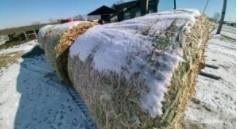By Richard Purdin
January is in the books and February has arrived. The beginning of February brings two things to my mind, first winter is halfway complete (I hope) and will that durn ground hog better not see his shadow! As I write this article there is officially 48 days, 14 hours, and 54 minutes until spring but who’s counting. One thing is for certain January was a halfway normal January for southern Ohio with wild weather swings and weather fronts bringing just about every type of weather you can think of. From rains, ice, sleet, and snow, we had it all. Through all this I was still able to keep livestock alive, but it was anything but easy. About 60% of my hay is made in large round bales and out of that 60% about 80% is stored outside and 100% of those round bales are net wrapped. In the last 20 years many producers have switched from sisal or plastic twine to woven net wrap to preserve and hold large round bales together. While it does present an increase cost in baling dry hay, it has much value in its ability to preserve dry hay stored outside, allowing for better water shedding and tighter/ denser bales. Most commonly producers will remove the net wrap or twine before setting the bale out to feed or grinding in a TMR mixer. Some producers will choose to leave the twine or net wrap on the bale and let the livestock eat around it, later picking up the net wrap afterword’s. The reason for doing this could be due to time constraints, older producer challenge with removing the net wrap, and frozen to the bale. These are all valid reasons but at the end of the day this presents a major risk to your livestock’s health. Livestock can accidentally ingest the net wrap.

Remove ALL the woven net wrap on frozen corn stalk bales
Carl Dahlen With North Dakota State (University beef specialist) research the amount of time it would take for different materials to break down in the rumen of beef cattle. The materials included sisal twine, plastic twine, 3 different types of woven net wrap, and hay. The results of the research showed that hay and sisal twine had a similar breakdown time in the rumen of about 100 hours but after 14 days the other materials were still completely intact. As cattle ingest the plastic twine or net wrap the cattle natural tendency to chew their cuds and forming wads of forage, regurgitating, and then swallowing again, this is the survival tactic that bovine developed long ago to survive. When you add plastic to the mix this could cause blockage of the esophagus or restrict the natural release of gasses from the rumen causing bloat. Death from bloat is not always the result of ingested foreign material but as animals consume plastic materials that can accumulate in the rumen, causing sever irritation, vomiting, weight loss, and diarrhea. If you have an animal showing these symptoms contacting your veterinarian as soon as possible. According to my local veterinarian there are very few good treatments but laxatives, mineral oils, or last case situations, surgery to remove the material. At the end of the day this is what I have learned on my farm,
- Watch the weather and be prepared for ice, snow, or sleet.
- Remove the net wrap well ahead of winter weather and have the bales close to the feeding site ready to feed before winter weather happens.
- Budget barn storage if finances allow for it. Winter is hard enough take time to remove the net wrap to avoid animal health issues.
Source : osu.edu